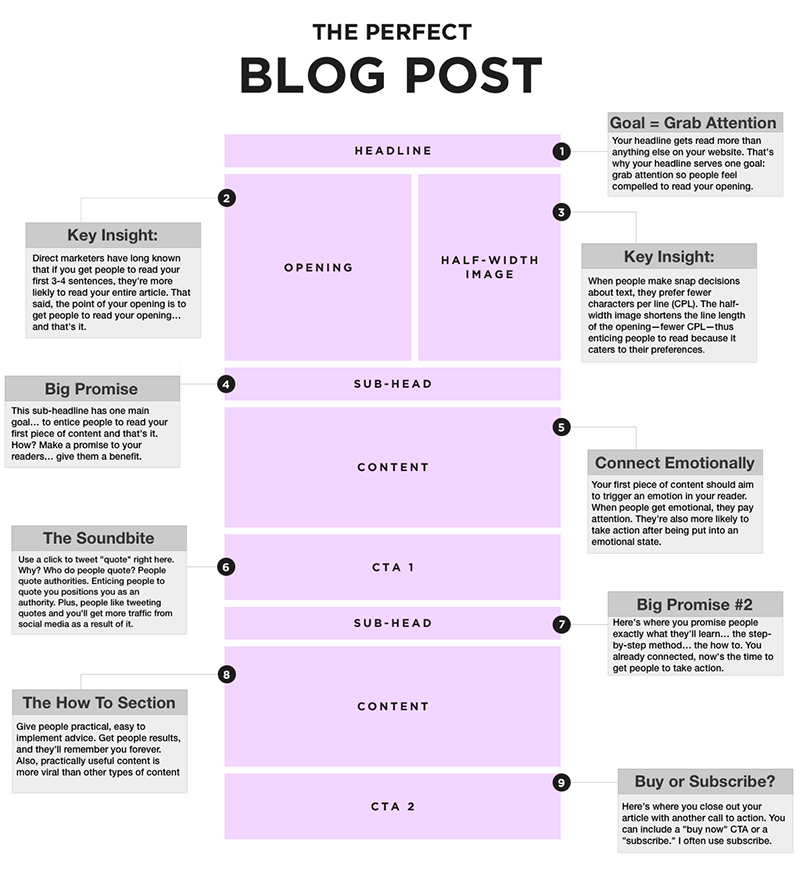The Perfect Blog Post: Simpler Really IS Better

The Perfect Blog Post: Simpler Really IS Better
I've designed my fair share of blogs and website from top to bottom, and while I've allowed myself to experiment some, I usually find that there is a formula for success.
This doesn’t mean that there are a bunch of hard and fast rules. It just means that successful blogs usually look a certain way for a reason.
In art school you're taught that you need to learn the “rules” of art before you're allowed to break them. The same goes for many things in life. Once you understand the rules, it will up to you to implement them, and break them, as you see fit.
Here are a few of the “rules” for blog design that I have adopted over the years.
Less Is Really More
Often, we equate working on our blog with installing a new widget on our sidebar. Trust me, your sidebar doesn’t need another widget. If fact, it probably needs less.
What you really need is a blog that works with your goals, and converts on your call-to-action. Sounds simple, but how do we get there?
- Our blog design must serve our content well. Your layout should make your content easy to read and experience. 100% of our blog design needs to be about the content that it is serving.
- A great blog design focuses on a single call to action. What do you want the reader to do when they come to your blog? You could pick seven different things. Pick one.
With that, I would like to introduce the anatomy of a “perfect” blog post:

The Blog Content
The content area of your blog should be the largest and most prominent. Your content is why your readers are here, and it should be:
Easy To Read
Use large, easy-to-read fonts with extra padding around the post and a fair amount of white space. Giving your content some breathing room will go a long way in making the post more readable.
Contain Inline Call-To-Actions
I like to include at least a few inline call-to-actions in each post. Prompting the reader to tweet a quote or a callout is easier than getting them to share a post at the end. To do this, we made our own custom Click To Tweet plugin which we later started giving away.
Minimize Meta Data
I usually try to keep meta-data to a minimum. When designing a blog, the author, category, and date information is up for debate. You will need to consider carefully your need for them. Keep it to the bare minimum.
Keep Sharing Buttons To A Minimum
I have personally come to believe that sharing buttons should be simple, minimal, and usually at the bottom of the post. After all, the post is about your content, not share buttons. Many blogs believe that more sharing buttons will equal more sharing, but that is rarely the case.
The Sidebar
The sidebar of your blog is becoming less and less important every day. You should evaluate it carefully, and it might be the first place where you start breaking some of the rules.
Placement.
Whether you place your sidebar on the left or right doesn’t matter, though the right side is a bit more traditional for a blog. Generally speaking, putting things where the user expects them to be is a good thing.
No Content.
Less is more, especially when it comes to the sidebar. Medium has popularized the no-sidebar blog post, and it works. In general, go for as little as you can stand to have in the sidebar.
Rethink The Standbys.
I used to believe that a list of categories and recent blog posts belonged on every sidebar. Once I dug into my analytics data, I discovered that these items were rarely used. They may not be so important, after all.
Search? Maybe.
Usually, I end up including a search box somewhere on my blog, but only because I so often use it myself. This element may or may not be important for you.
Don’t Buy Ads On Your Own Blog.
You may be tempted to fill your sidebar with a link to every “important” part of your site. Don’t. I never take out ads on my own blog, and you shouldn’t either.
The Call to Action
One of the reasons that I find all of this so important is that with social sharing and search engines, our blog is often the first thing that our readers or future customers will see. In essence, your blog is your homepage. It is not only important to make a good first impression, but it is also important to make sure that you are not asking too much of them on their first visit.
I often think about a website visitor in terms of a dating relationship.
If you’ve just met someone for the first time, you don’t ask them to marry you. You have to get to know them first. The same goes for blog visitors. What is the most reasonable thing that we can ask of them? Are you trying to get them to the altar when you need to get to know them better?
Your blog is about converting visitors into readers, not trying to marry someone on the first date.
The correct call-to-action for any inbound blog is a simple request that converts a visitor into a long time reader.
This could be accomplished through an email signup, a Twitter follow, or even an RSS subscription. While I prefer to push for an email subscription, the method doesn’t matter too much. The big idea here is that you shouldn’t be trying to sell them something on your first meeting. The purpose of your call-to-action should be to provide an avenue for them to get to know you a little better.
If they become a subscriber, and slowly learn to rely on your content, they will eventually become accustomed to what you are really selling. Over time, they may even become a true paying customer.
Looking for help with blogging for YOUR business?
Reach out to our team on online marketing experts, or use this guide --one of the methods that we advocate for finding your own minimized blog is to make a list of everything that you have on your blog and then prioritize it from most to least important. Then, starting at the bottom, begin cutting the fat as you move up the list. Depending on your current approach, you might be able to cut 30-50% of the stuff on your blog right now. The big idea here is that you only need to worry about two things on your blog: the content, and the call-to-action. By slimming down the design you make it easier for your visitors to understand this, and you make it easier for them to actually follow through.
Keep it simple, and I promise that you will find the perfect blog post over your very own.